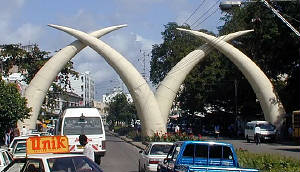| Tuesday morning was an early
start, with breakfast at 6:30 am, ready to leave at 7 for the Kuoni day
trip to Mombasa. A very familiar kind of minibus arrived to pick us up
and head South along the coastal highway, which like virtually all roads
in Kenya was in awful condition.
About half way to Mombasa, we stopped to pick up some other people at
another hotel. We were initially surprised to find that two of them were
the Quilters. In retrospect it shouldn't have been too much of a
surprise, because it was a Kuoni trip and in fact there were others from
our Safari who also signed up for this day tour. |
|
The Handicraft Centre
First stop in Mombasa was the handicraft centre. This is the source
of many of the carved animals and other curios that are on sale all over
Kenya.
There is a sprawling "shanty town" of small work shops
where men, women and some children sit on the floor with very basic
tools carving and painting a wide variety of objects.
There is a large shop with all items individually priced .. a
pleasant change from the normal system of negotiating a price .. and
surprisingly low. Each item is marked with the identity of the craftsman
who made it, so there is a direct payment back.
|
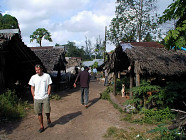 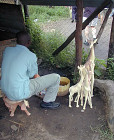
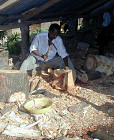 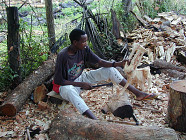
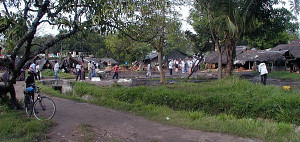
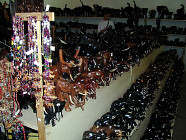 
|
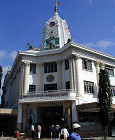 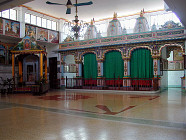
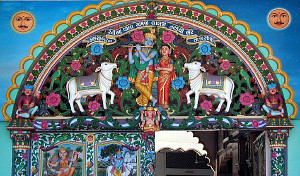 |
The Buddhist Temple
We had two attempts to visit the Buddhist Temple. The first time, we
were able to admire the exterior, but the building itself was closed for
cleaning.
A little later we returned and were able to walk around the inside,
but the main rooms of the temple were closed and the photographs we took
we through bars.
|
|
The Indian Ocean Coast
The next part of the tour was a drive along the coast to the old
port.
In addition to the bridge, there is a heavily utilised ferry to get
across to the South of the river estuary. The Indian Ocean coast itself
was almost deserted.
One interesting feature was the sponsoring of litter bins by local
businesses. |
 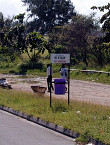
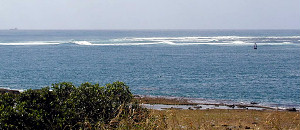
|
|
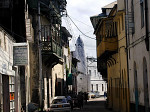 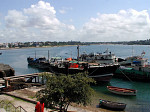
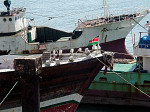 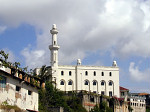
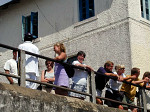 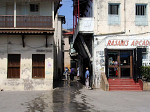
|
The Old Port
Next stop was the narrow streets of the old port area of
Mombasa. We stopped in Government Square and walked down through the old
port to the quays, still used by some ships.
The quay afforded a great view of the local mosque.
The girl to the left of Sue looking over the railings
was on her honeymoon (married to the guy walking around in the first
picture of the handicraft centre).
Finally we ended up in the shop just to the right of the
narrow alley in the bottom right photograph.
|
|
Fort Jesus
Final stop before lunch was Fort Jesus, a 17th/18th
century fortification with a dominant position overlooking the waterway
into the old port.
We successfully evaded the attempts of the locals to
give us a guided tour and managed to stroll around at our leisure.
|
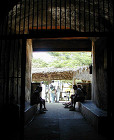 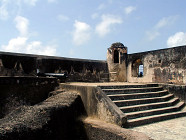
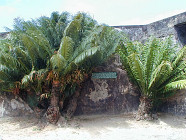 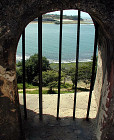
 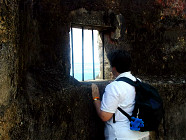
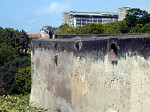 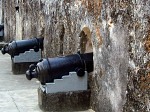
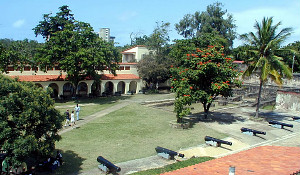
|
|
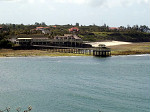 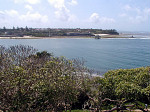

|
Fort Jesus dominated the approach to old
Mombasa as these photographs taken from the canon positions shows. |
| Everywhere in Kenya, interesting wildlife is
never far away. These two Agamas, one male and one female popped out
while we were waiting for the rest of the group to finish their guided
tours. |
 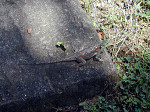
|
|
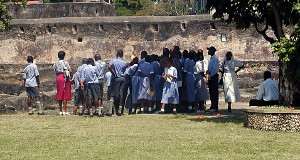
|
There were a number of school trips visiting
Fort Jesus. All of the young people seemed genuinely interested and
listening attentively to their teachers. |
| One the way to lunch we drove once around the
spice market. It seemed impossible that out minivan would actually get
through the crowds and narrow streets, but somehow we made it. |
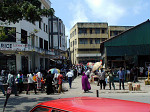 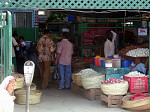
|
|
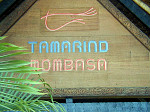 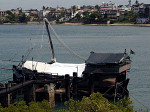
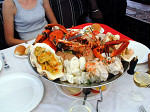 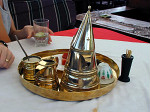
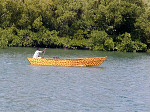 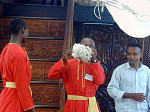
|
Tamarind Dhow
Lunch was taken at one of the top restaurants in Mombasa,
the Tamarind, renowned for its seafood.
In fact, our group had lunch during a cruise on the
restaurant Dhow, cruising around the river estuary.
One our table, we all chose the seafood platter, which
arrived beautifully presented on a huge plate. Even the coffee pot was
distinctive.
While we were eating, there was live music and we went
round and round close to the strangely painted boat. Approaching the
landing at the end of the cruise, one of the crew attracted attention by
blowing on a conch shell.
|
| On the trip back down river, we had a great
view of the Mombasa waterfront.
The lower picture in fact shows the old port that we visited earlier
in the day.
|
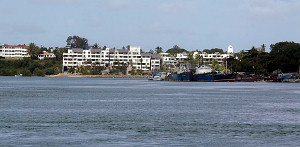
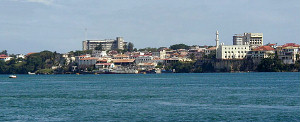
|
|
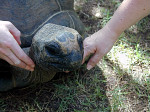 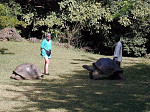
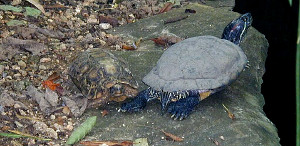
|
??? Wildlife Park
The final stop of the day was a wildlife reserve just North of
Mombasa. Next to a cement works, the reserve is actually owned and
sponsored by the cement company.
On the walk from the car park, there are a number of Giant Tortoises
(from the Seychelles) some of which are more than 100 years old.
|
| The main features of the park are the
crocodiles and hippos. There are a large number of crocodiles, living in
reasonably large enclosures and relatively natural conditions. |
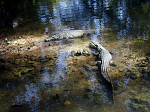 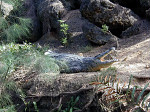
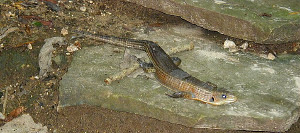
|
|
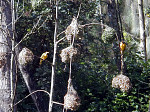 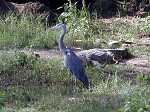
 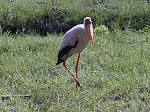
|
Around the park, there are a number of species
of birds, including
- Weaver birds
- Grey heron (alongside the crocodile)
- Secretary birds (near the hippo pond)
- ???
|
| There are two adult hippos and a youngster.
The adults live in a pond and a heap of cereal attracts them out of the
water at a fixed time every afternoon (so the crowds build up at that
time).
When the food is first put out, the other animals, including birds,
monkeys, buffalo and antelope start to feed. As soon as the hippos come
out of the water, the other animals keep very well clear.
The young hippo lives in a separate enclosure in a weed covered pond.
For most of the time it is difficult to spot, but occasionally appears
above the water to breath.
|
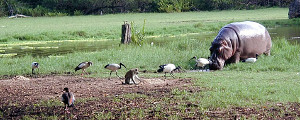
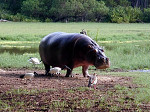 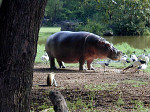
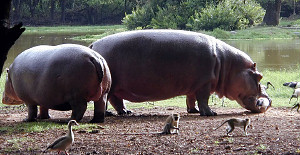
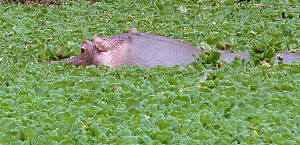
|
|
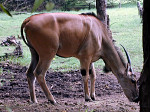 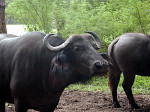
|
The gazelle and buffalo wait patiently while the
hippos feed. |
| The beobab tree in the right picture was
planted by ???? and is being very carefully looked after. The picture on
the left shows the fruit of the beobab. |
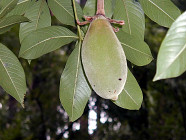 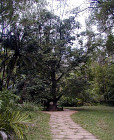
|
|
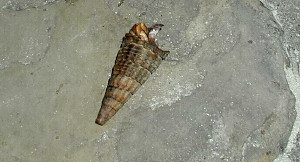
|
Back in the hotel, we relaxed after dinner in
the beach bar. This hermit crab scuttled across the paving on the side
of the pool. |
